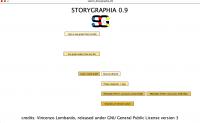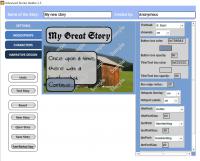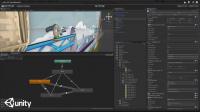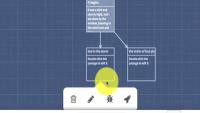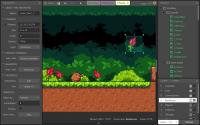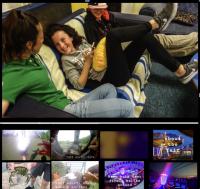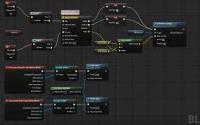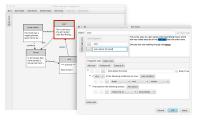IDN authoring tools
-
Storygraphia
Is a programme developed in Processing which implements the editing and visualization of an interactive story graph. -
ASAPS (Advanced Stories Authoring and Presentation System)
Developed by Hartmut Koenitz during his PhD. studies at Georgia Tech ASAPS is meant to showcase the creative potential of the IDN form. Though used by Koenitz in multiple courses this tool was never publicly released and remains in advanced stages of beta. It is available on demand and runs its products via communication with a Flash runtime engine. ASAPS is notable for its combination of nodes and links authoring structure with a variety of additional elements called beats meant to comfortably integrate relevant aspects of IDN works (e.g. conversation choices inventory items global variables) and for being the only academic tool that's the subject of a paper analyzing the corpus of products made with it. -
Unity
Unity is a cross-platform game engine developed by Unity Technologies which grew to become the most widely used all-purpose game creation engine. Most recognized with 3D game development the engine is also commonly used for 2D and mobile game development as well as XR media interactive simulations and other experiences. It is cited to be easy to use for beginner developers and is popular for Indie game development as well as AAA game development (products include Pokémon Go Call of Duty Beat Saber and Cuphead). While not emphasizing narrative authoring a high amount of narrative games are written with Unity due to the tool's popularity and plugins such as Fungus enable a more narrative-centered work environment. -
Twine
Twine (and Twine 2) is the most widely-used tool for interactive fiction authoring. It is an open- source HTML-based tool that’s user-friendly intuitive and easy to learn. Twine highlights the visual structure of a hypertext story: the interface is based around creating and editing hypertext units (“passages”) and controlling their organization in an abstracted space. New hypertext units are created by typing in existing ones either through links or conditional logic. -
Construct 3
Construct is an HTML5-based 2D game editor developed by Scirra Ltd. It is aimed primarily at non-programmers allowing quick creation of games through visual programming. Construct 3 works on a subscription-based model as a web app and currently supports web embeds through HTML5 uploading to Facebook Instant Games Construct Arcade as well as being formatted to interactive advertisements. -
Korsakow
The Korsakow System (Pronounced 'KOR-SA-KOV') is a software for creating browser-based dynamic documentaries. Invented in 2000 by Berlin-based artist Florian Thalhofer Korsakow allows users without any programming expertise to create and interact with database-driven narratives called Korsakow-Films or K-Films. The software can be used to produce documentary experimental and fictional narrative works and has been integrated into live performance and installation pieces. K-films are created from an indexed archive of units in video format. A K-film project consists of minimal narrative units called SNUs (Smallest Narrative Units) with associated keywords. A published K-film consists of an HTML interface with a main video window that starts automatically when loaded into a web browser and other thumbnails that appear within the interface as buttons for loading additional video clips. -
Unreal Engine
Originally developed by Epic Games for their shooter game Unreal Unreal Engine grew to be one of the most popular game engine worldwide alongside Unity. While its technical and visual affordances for the design of detailed 3D environments characters and physics are almost unrivaled it is very tough to learn and includes little support for narrative authoring. While a full-scale project requires coding in C++ the blueprint mode allows beginners and prototype developers to create functional project using readymade assets and preset schemes – making charting out a prospective project with Unreal comparably comfortable (though still requiring a learning curve and some graphical know-how). *My classification of this tool tries to account for both the relatively amateur-friendly Blueprint mode which is based on visual templating and Unreal's more advanced primary authoring mode based on abstract coding and design from scratch -
Inklewriter
Inklewriter is an interface-based tool to generate interactive fiction. The basic units are "sections" each of which can contain a textual description or an image. Each section can have one or more "options" which lead to another node with possibly other options etc. The tool allows conditionally hide certain options or sections. The GUI also provides: basic text formatting an option to stitch two or more paragraph together a way to insert additional paragraphs and an option to include pictures. It is also possible to see an interactive map of contents tracking the steps taken and a summary of the content. The results are playable inside inklewriter. It is also possible to donwload the final product but this is done using an escamotage (explained by the creators of the tool). -
Texture
Texture is a browser-based authoring tool that focuses on “word-on-word interaction” which involves creating actions that can be used to trigger behaviours when dragged onto a word within a page. These behaviours can involve changing values of flags replacing or adding text to the current page or conditionally jumping to another page. The emphasis is on ease of authoring ease of playing and ease of publishing. The tool was initially intended as a way to explore the “possibility space between Inform and Twine” and to allow for interaction on a touch screen device. -
HypeDyn
HypeDyn is a tool for authoring node-and-link based stories with support for the inclusion of procedural elements such as conditional links procedural change of node content and procedurally generated links (“sculptural hypertext”). It was originally developed in 2009 as a free substitute for StorySpace and used internally in the Department of Communications and New Media (CNM) for teaching interactive storytelling. Unreleased variations have been developed to support mobile stories and “thematic” links. A reimplemented version was released in 2015 and has been used for teaching and the development of a small number of publicly released works.
